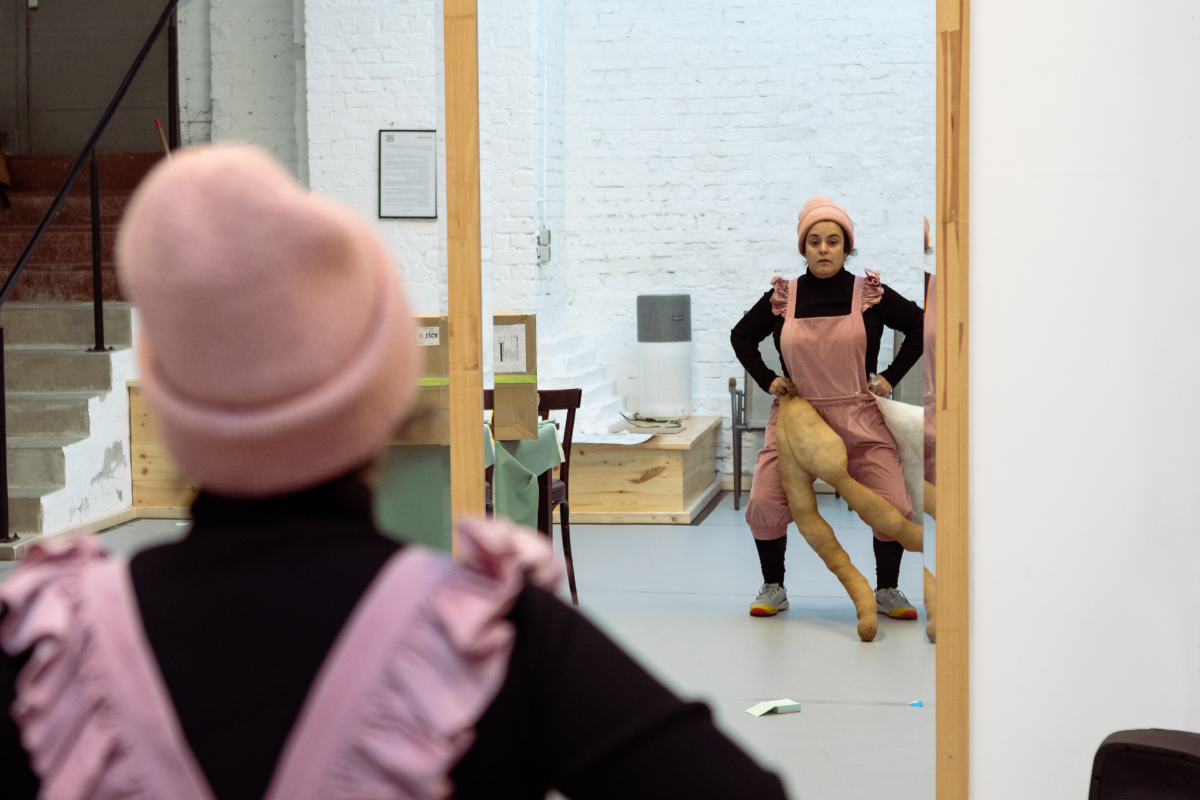Exploring the Absurdities of Life
We are delighted to welcome Gabriela Muñoz to the Chamäleon. Gabriela’s work is full of whimsical, intricate imagery and visual metaphors that evoke a wide range of emotions. She recently moved into our rehearsal space in order to work on her fourth solo piece, „Julieta“.
Together with the Ruhrfestspiele Recklinghausen, we are supporting „Julieta“ as co-producer and can’t wait to bring this wonderful piece to life. In this interview, Gabriela talks more about her work, the leap into the unknown and how ideas and inspiration turn into beautiful imagery.

„Julieta“ is your 4th solo piece. Please tell us a little bit about your work and the themes you want to explore.
I started writing „Julieta” a while ago. I had the idea because I started working in a home for the elderly and I was also reflecting on my great-aunt, the aunt of my mother. I saw her more as my grandmother, really. I kept thinking about how full of life she was and just how wonderful she was. And how I longed to be that kind of woman one day. So, when the opportunity came and the MICC Working Group in Montréal asked me to pitch an idea, this is what I wrote.
I wanted to create a bit of an homage to her and her life. Then I started thinking more about the perspective, specifically a female perspective on what growing old means. Basically, that was my first theme for the piece. I think, the more I do it and dig deeper into the subject, the more I understand many other layers that are mirroring me as I transit through this journey.
And in a sense the piece is really about celebrating life. I think it is relevant both in this concept and in this moment to find colors, where sometimes you can’t see them. I want to create a piece that talks about metamorphosing or changing your skin into becoming a freer version of yourself. I realized that by growing old spaces become smaller and life in itself becomes sort of these final laps of life. So, I’m thinking about how to translate all this information into images, into something that’s poetic and hopeful. Maybe hopeful is a strange word to use. But something that reflects on having a full life and on what it is to be alive and to celebrate life.

It seems you often explore themes of self-discovery in your art and use it to grapple with topics that are quite complex. Why did you choose this art form in particular and what is it that fascinates you about clowning?
I think there’s a lot of humanity in clowning. Not only the humorous part of it or the funny moments, but it’s a way to explore the absurdities of life on its own. And I think that’s where I find the comedy and the humor, I find it in the small, awkward moments and moments that are very, very human and that we can all recognize. I think in my art form or in my work I like to touch on both things: realism, but mixed with fantasy. I want to create things that give an idea of another parallel world of possibilities and allows us to see life with different glasses.

Your work is always so full of vibrant images. What kind of images are your thinking of creating for „Julieta“?
Normally I’m used to playing with the audience a lot, but ever since Corona I knew that I could not have lots of people playing with me. So I thought, who else could be my co-worker on stage and I thought well, maybe it should be the space and the set. So that should be able to translate to what I want to achieve in the narrative.
Currently, there are many images or ideas in my head that I want to change into something visual. Those are very clear to me and now I have many things to try out and rehearse (laughs). But I’m excited about the idea of merging into something deeper. And it won’t necessarily be light. When I think of a full life, then I think that we’re all full of black and whites, life and death. I think I have a good grasp of the light side and now I’m entering into the other side, too. I always like to work with dualities. Because I think that’s what makes a work very accessible for people in order to connect and to empathize. I want to mirror myself into finding some answers to my questions.

Can you tell us a little bit about your process? How do you go about trying things out and making the images in your head real?
I think I have very clear images or scenes that come to mind. I just try to jump straight into them with no judgment or fear of what might or might not work or happen. Because what I have in my head is one thing, but once I start moving and working, it might take me somewhere completely different.
I ask myself all the time, is this somewhere I’m willing to go? Am I willing to go to the unknown and to live the process? Instead of getting a result straight away. I think working like that is very nice and frightening. But I’m mostly surprised, positively surprised. I’m surprised with the outcome many times. So the main challenge lies in sort of setting up my brain (laughs). And then jump into the void, hoping I won’t crash.

„Julieta“ received preliminary support from FONCA and the MICC Working Group on Circus Commissioning (TOHU, Montréal), an international consortium dedicated to advancing new circus globally.
„Julieta“ will be premiered at the Ruhrfestspielen Recklinghausen on May 26, 2022. Further information and tickets can be found here.
Photos: Gianluca Quaranta


